When you buy through our links, we may earn a commission. Products or services may be offered by an affiliated entity. Learn more.
A full mattress is a versatile option for shoppers who need something bigger than a twin, but who aren’t ready for the size or cost of a queen. Also known as a double, this size is great for those with limited bedroom space, younger sleepers, and people who sleep solo. It’s also a cost-effective solution for furnishing guest rooms and flex spaces without compromising on comfort.
- Our favorite full mattress is the Helix Midnight Luxe, which showed off its impressive pressure relief and targeted lower back support in our Test Lab.
- In our guide, you can learn how your sleep position, body weight, and subjective firmness preferences play a role in finding the best possible full mattress for you.
- Want to quickly review your options? Watch 1-minute videos about our top picks.
Our Top Picks
-
Best Mattress Overall – Helix Midnight Luxe
View Details
-
Most Comfortable Mattress – WinkBed
View Details
-
Best Mattress for Back Pain – Bear Elite Hybrid
View Details
-
Best Mattress for Side Sleepers – Nolah Original 10
View Details
-
Best Luxury Mattress – Birch Luxe
View Details
-
Best Mattress for Kids – Helix Kids
View Details
Swipe for more
Best Mattress Overall
Helix Midnight Luxe
9.7 /10
Test Lab Score
25% off sitewide
25% off sitewide
The Helix Midnight Luxe is our top overall pick if you’re looking for a full mattress. It offers everything you need, including gentle pressure relief for spinal alignment and moderate bounce to keep you well-positioned on the mattress.
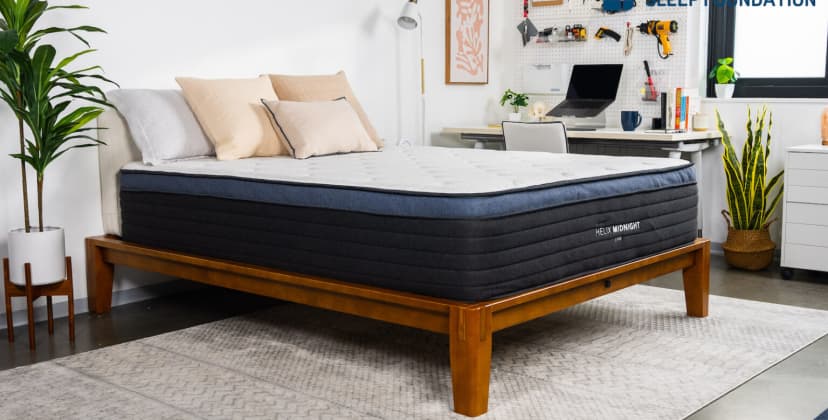
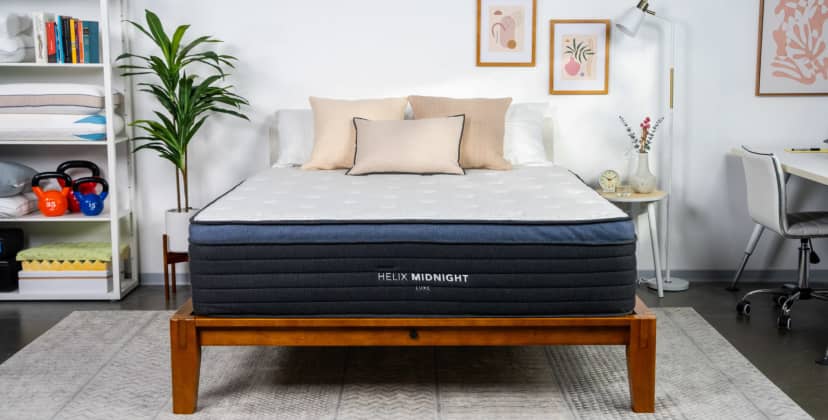
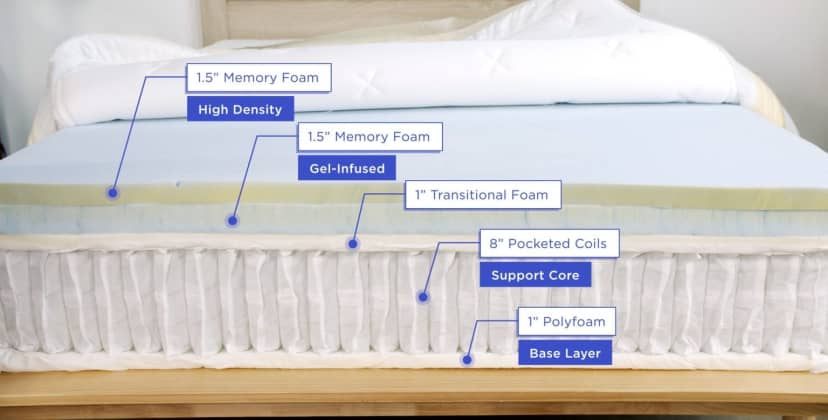
Credit: Sleep Foundation Test Lab
Price
$1,799
Mattress Type
Hybrid
Firmness Options
Medium Firm (6)
Trial Period
120 nights (30-night requirement)
At a Glance
- Who It’s Best for: Side and back sleepers up to 230 pounds.
- Feel: Balanced medium firm (6) design with light contouring and targeted support for the midsection.
- What It’s Made of: Memory foam comfort layers encased in a Euro-top, followed by transitional foam and zoned pocketed coils with reinforced edges.
- What We Don’t Like: Too soft and lacking in support for most back and stomach sleepers over 230 pounds.
Scoring & Reviews
The following ratings show how suitable this mattress is for different sleeping positions and sleeper weights. These scores are determined by how well the mattress supports and relieves pressure for each sleeper type.
We performed a meta-analysis on 5876 validated customer reviews of the Helix Midnight Luxe. This is what people who bought the mattress had to say:- Comfort and Support: Many reviewers express that the mattress provides exceptional comfort and support, especially noting its ability to alleviate back, hip, and shoulder pain.
- Sleep Quality Improvement: The mattress is frequently described as transformative for those who previously struggled with sleep disturbances.
- Temperature Regulation: Positive remarks are made about the cooling properties of the mattress. Users find the cooling aspect effective, helping to maintain a comfortable sleeping temperature throughout the night.
- Customer Service: Experiences with customer service are predominantly positive, with buyers appreciating the responsive and helpful nature of the support team. Issues are resolved satisfactorily, contributing to a positive overall customer experience.
- Durability Concerns: A few reviewers express concerns about the mattress showing signs of wear or sagging prematurely. These concerns are not widespread but are significant enough to be noted by potential buyers.
- Mixed Reviews on Firmness: While many find the mattress perfectly balanced, there are mixed reviews regarding its firmness. Some users find it softer than expected given its firmness level. While the ‘medium firm’ rating is appropriate by our measurements, the bed does have a ‘cushy’ foam feel that makes for a fairly soft surface feel.
Full Details
Helix Sleep’s mattress lineup includes more than two dozen hybrid models specifically designed for certain types of sleepers. The Helix Midnight Luxe may be intended for side sleepers who weigh 130 to 230 pounds, but our testing shows back sleepers in the same weight range and lighter stomach sleepers also find the mattress quite comfortable. Its versatility can be attributed to a balanced medium firm (6) feel that combines the contouring of memory foam with robust coil support.
How It Performed
The Midnight Luxe earns above-average ratings for pressure relief compared to other hybrids. The foam layers provide even cushioning for areas of the body prone to pressure buildup, such as the shoulders and hips. The transitional foam also serves as a buffer for the support core, so most sleepers up to 230 pounds shouldn’t sink too deeply into the mattress.
Edge support is another strength of the Midnight Luxe. The reinforced coils allow you and your partner to use the entire mattress surface, so you shouldn’t feel confined to the middle during sleep or sex. Steady airflow through the coils also helps the mattress sleep cool.
Construction Breakdown
The mattress begins with two comfort layers of memory foam, followed by a transitional polyfoam layer. Individually pocketed coils reinforced with high-density polyfoam make up the support core. The coils are reinforced along the perimeter to create pushback when you sleep near the edges of the mattress or get in and out of bed. A breathable Tencel cover encases the mattress, but if you’re a hot sleeper, you can upgrade to a cover made of GlacioTex fabric that feels cool to the touch at all times.
Trial, Shipping, and Warranty
The Midnight Luxe has a competitive price-point for a hybrid model, and Helix Sleep offers free ground delivery throughout the contiguous U.S. Each order comes with a 120-night sleep trial that includes free return shipping, and those who choose to keep the mattress also receive a lifetime manufacturer’s warranty.
Best Value Mattress
Brooklyn Bedding CopperFlex Memory Foam
8.6 /10
Test Lab Score
30% off sitewide
30% off sitewide
If you’re shopping for a mattress with a limited budget, the Brooklyn Bedding CopperFlex Memory Foam is an affordable option with great long-term value. This all-foam mattress features plush comfort layers that conform closely, a zoned transitional layer that pushes back against your midsection, and high-density foam in the support core for extra stability.

Credit: Sleep Foundation Test Lab
Price
$466
Mattress Type
Foam
Firmness Options
Medium Firm (6)
Trial Period
120 nights (30-night requirement)
At a Glance
- Who It’s Best for: Side and back sleepers who weigh 230 pounds or less
- Feel: Cushy surface that contours closely with targeted pushback for the torso and hips.
- What It’s Made of: Adaptive polyfoam and copper-infused memory foam comfort layers, zoned transitional foam, and a support core of high-density foam.
- What We Don’t Like: Despite the firmer-than-average design, edge support is limited.
Scoring Breakdown
The following ratings show how suitable this mattress is for different sleeping positions and sleeper weights. These scores are determined by how well the mattress supports and relieves pressure for each sleeper type.
We performed a meta-analysis on 549 validated customer reviews of the Brooklyn Bedding CopperFlex Memory Foam. This is what people who bought the mattress had to say:- Pricing and Value: Many reviewers have highlighted that the mattress is affordable and offers great value for the price, making it an excellent choice for budget-conscious shoppers.
- Heat Regulation: Several users noted that the mattress does not retain much heat, which contributes to a cooler and more comfortable sleep, especially for those who tend to sleep hot.
- Edge Support: The mattress is reported to have good edge support, which is beneficial for those who use the edge of the bed frequently or sleep close to the sides.
- Odor and Off-Gassing: Some reviews mention that the mattress has minimal off-gassing odor upon unpacking, which is a common concern with new mattresses. The smell will dissipate in a few days.
- Hybrid Option: The availability of hybrid models is appreciated, particularly for those needing more support, such as individuals with larger frames.
- Customer Service: Positive remarks about customer service suggest that the company handles queries and issues effectively.
Full Details
The Brooklyn bedding CopperFlex Memory Foam offers excellent bang for your buck compared to a lot of competing all-foam mattresses on the market. Delivering a balanced medium firm (6) feel, the CopperFlex offers even contouring and zoned support to ensure comfy cushioning without too much sink beneath the heavier areas of your body.
How It Performed
Based on our hands-on tests, we’re recommending the CopperFlex Memory Foam to side sleepers who weigh at least 130 pounds and back sleepers up to 230 pounds. Stomach sleepers on our team weighing less than 130 pounds also awarded the mattress high marks. Zoned transitional support proved to be a major reason why our team was so impressed with the CopperFlex, as many of us find all-foam mattresses generally don’t provide enough support.
Temperature control is also above average. A cooling copper infusion in the top memory foam layer and breathable GlacioTex cover effectively offset a fair amount of heat retention, allowing you to enjoy the comfort system’s “hugging” effect without feeling overly warm.
Construction Breakdown
The CopperFlex’s comfort system contains four layers, beginning with adaptive polyfoam sewn to the cover and followed by two memory foam layers. Copper fibers infused in the top memory foam layer are intended to draw heat away from the surface. The fourth layer consists of transitional polyfoam divided into three firmness zones with extra support for your midsection. Two high-density polyfoam layers in the support core stabilize the entire mattress, and the cover is composed of GlacioTex fabric engineered to feel cool to the touch at all times.
Trial, Shipping, and Warranty
In addition to its approachable sticker price, the CopperFlex Memory Foam qualifies for free ground shipping within the contiguous U.S. Each order comes with a 120-night sleep trial. If you choose to keep the mattress after the trial ends, your purchase is also backed by a lifetime warranty against structural and material defects.
Most Comfortable Mattress
WinkBed
9.4 /10
Test Lab Score
30% off all WinkBeds mattresses
30% off all WinkBeds mattresses
Our pick for the best full mattress for people with back pain is the WinkBed. Offered in four firmness levels, it suits virtually any sleeper. Standout pressure relief and support encourage spinal alignment so that there’s less twisting and strain on your back.
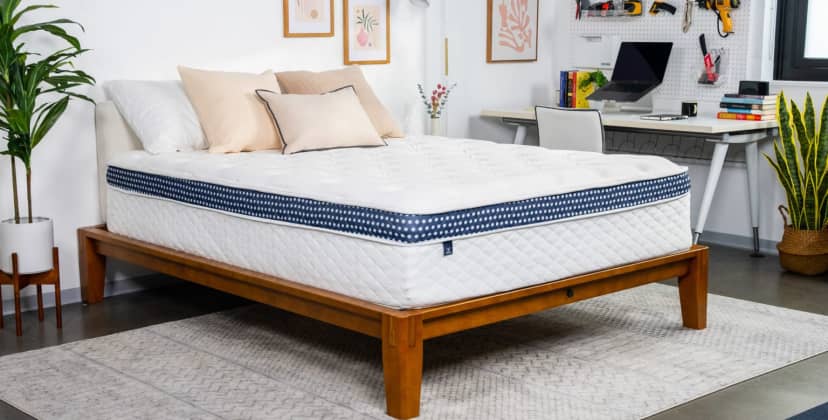
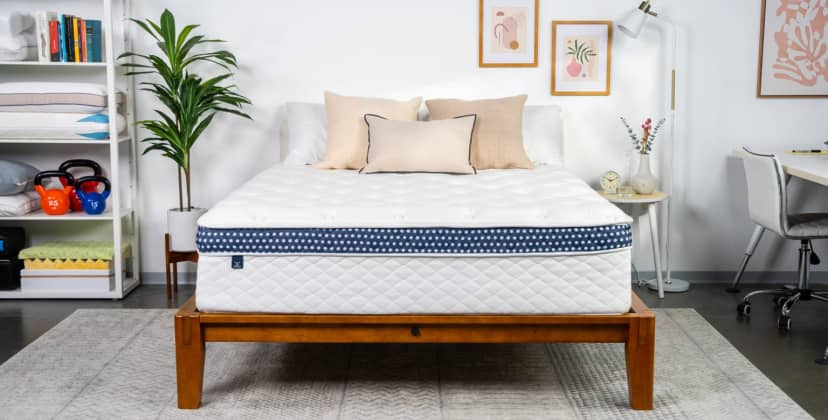
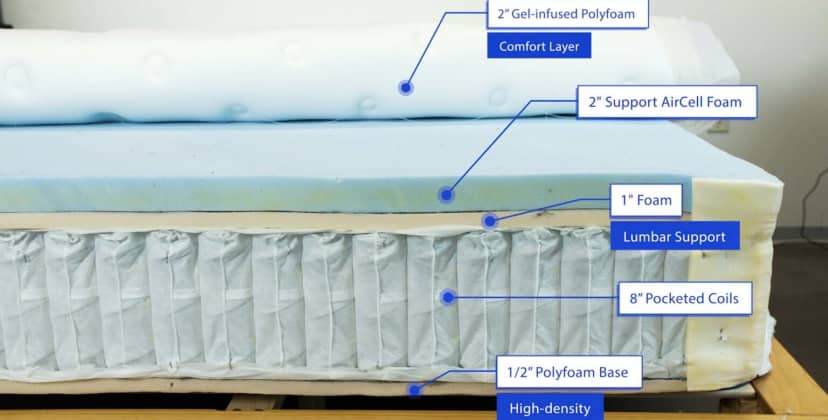
Credit: Sleep Foundation Test Lab
Price
$2,570
Mattress Type
Innerspring
Firmness Options
Medium Soft (4), Medium Firm (6), Firm (7), Firm (8)
Trial Period
120 nights (30 night requirement)
At a Glance
- Who It’s Best for: Most side, back, and stomach sleepers across different weight groups.
- Feel: You can choose from cushy medium soft (4), balanced medium firm (6), supportive firm (7), and ultra-bouncy “Plus” (8) designs. All offer targeted support for the midsection.
- What It’s Made of: The WinkBed Plus contains a zoned latex comfort layer, whereas the other three are constructed with adaptive polyfoam. All feature zoned pocketed coils with perimeter reinforcement.
- What We Don’t Like: Initial off-gassing odor may linger up to 72 hours after the mattress is unboxed.
Scoring & Reviews
The following ratings show how suitable this mattress is for different sleeping positions and sleeper weights. These scores are determined by how well the mattress supports and relieves pressure for each sleeper type.
We performed a meta-analysis on 8573 validated customer reviews of the Winkbed. This is what people who bought the mattress had to say:- Pain Relief and Support: A significant number of users report alleviation of back, hip, and shoulder pain, attributing this to the mattress’s supportive design. Individuals with chronic back issues have noted substantial improvements in sleep quality.
- Comfort Across Sleep Positions: Reviewers from various sleep positions—side, back, and stomach—find the mattress comfortable. The availability of different firmness levels allows users to select options that best suit their sleeping style.
- Temperature Regulation: Many customers appreciate the mattress’s ability to stay cool, enhancing overall comfort throughout the night.
- Edge Support: Users frequently mention the robust edge support, which provides a stable and usable sleeping surface across the entire mattress.
- Firmness Options: Customers appreciate the variety of firmness options available, finding the right balance for their personal preferences.
- Durability and Craftsmanship: The mattress is often praised for its high-quality construction and materials, with users expressing confidence in its longevity. The lifetime warranty further reinforces trust in the product’s durability.
- Customer Service and Trial Experience: Customers value the 120-night risk-free trial and responsive customer service, noting that these factors contribute to a positive purchasing experience.
Full Details
If you live with back pain, you should prioritize a mattress that cradles and cushions sore spots in the shoulders, lumbar region, and hips. The WinkBed is a foam hybrid with a thick comfort system and ultra-supportive coils. These components ensure even contouring with minimal sinkage around the midsection.
How It Performed
We tested all four of the WinkBed’s firmness levels and found unique strengths for each one. The Softer model provides the deepest cushioning and feels highly adaptive. This was the most popular design among our team’s side and back sleepers who weigh less than 130 pounds. Our back and stomach sleepers weighing at least 130 pounds gave stellar ratings to the Luxury Firm, as did side sleepers of 130 to 230 pounds. We found this design to be the most balanced, with moderate contouring and sturdy support from head to toe. Testers on our team weighing more than 230 pounds also appreciated the extra reinforcement from the Firmer and WinkBed Plus models.
Temperature control was another area where the WinkBed excelled across all firmness levels during our tests. The Tencel cover is both breathable and moisture-wicking, resulting in a surface that feels comfortable at all times, and the coils generate enough airflow to keep the interior cool. We were also impressed by the excellent edge support and ease of movement. Even the Softer model sank very little when we sat along the perimeter and moved across the surface.
Construction Breakdown
Customers select from four firmness levels for their WinkBed. These include the Softer, Luxury Firm, and Firmer models. In terms of firmness, these mattresses are considered medium soft (4), medium firm (6), and firm (7), respectively. You can also choose the WinkBed Plus (8), which is specifically designed for people who weigh more than 230 pounds.
A layer of adaptive foam quilted into the WinkBed’s cover gives the mattress a plush surface feel. Softer, Luxury Firm, and Firmer models contain a polyfoam comfort layer that conforms evenly as your body settles. The WinkBed Plus features a latex layer that makes the surface feel bouncy, which can help you move more easily across the mattress.
The support core consists of pocketed coils arranged in a zoned formation. Thicker coils located beneath the torso and hips help keep your body on an even plane, while thinner coils cradle lighter areas of your body such as the head, shoulders, and hips. The perimeter coils are also reinforced to reduce sinkage. A cover made of Tencel encases the mattress.
Trial, Shipping, and Warranty
WinkBeds offers free ground shipping throughout the contiguous U.S. Your order comes with a 120-night sleep trial. If you decide your initial firmness selection is not right for you, the company allows you to exchange the original mattress for a new model. The replacement also receives a 60-night trial period. All WinkBed mattresses are covered under a lifetime manufacturer’s warranty.
Best Mattress for Back Pain
Bear Elite Hybrid
8.5 /10
Test Lab Score
40% sitewide with code: SF40
40% sitewide with code: SF40
The versatile Bear Elite Hybrid offers strong all-around performance, making it our top option for combination sleepers searching for a new full mattress. Powered by its hybrid design, the Bear Elite Hybrid adapts to your body, giving essential support even as you adjust from one sleeping position to another.
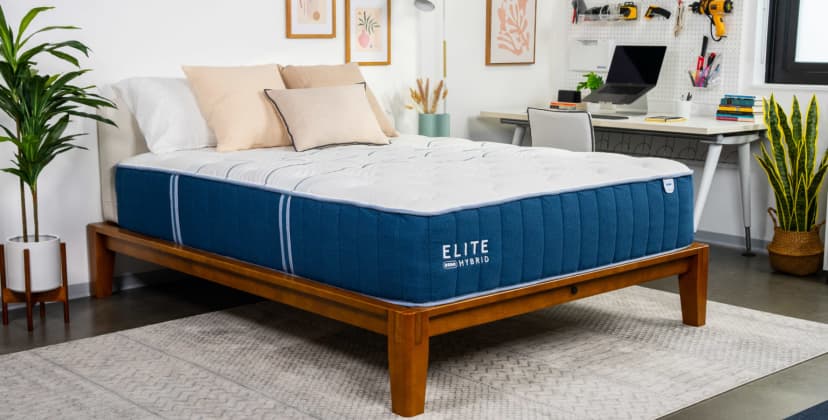
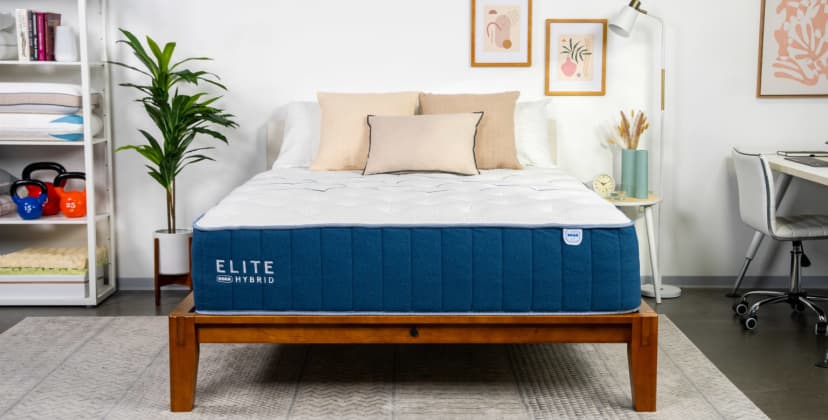
Credit: Sleep Foundation Test Lab
Price
$1,499
Mattress Type
Hybrid
Firmness Options
Medium (5), Medium Firm (6), Firm (8)
Trial Period
120 nights (30-night break-in period)
At a Glance
- Who It’s Best for: Side, back, and stomach sleepers of any weight – but choosing the right firmness for your body type is important.
- Feel: You can choose from medium (5), medium firm (6), and firm (8) designs, all with extra pushback to prevent your torso and hips from sinking too much.
- What It’s Made of: Gel-infused memory foam and zoned transitional polyfoam, followed by seven-zone coils with extra reinforcement around the edges.
- What We Don’t Like: Foam layers can hinder movement on the surface and make it difficult to change sleep positions.
Scoring & Reviews
The following ratings show how suitable this mattress is for different sleeping positions and sleeper weights. These scores are determined by how well the mattress supports and relieves pressure for each sleeper type.
We performed a meta-analysis on 3703 validated customer reviews of the Bear Elite Hybrid. This is what people who bought the mattress had to say:- Comfort and Support: Many reviewers highlight the mattress’s balance of comfort and support, often mentioning relief from back pain and improved sleep quality.
- Firmness Options: Customers appreciate the various firmness options, with some opting for firmer versions after experiencing discomfort with medium firmness.
- Temperature Regulation: Several reviews note the mattress’s ability to stay cool, which enhances sleep quality, especially in hot weather.
- Size and Upgrade Options: Customers are pleased with the availability of different sizes and the option to upgrade, which provides flexibility for different needs and preferences.
- Quality of Additional Products: Positive remarks on the quality of accompanying products like pillows and sheets, which are often included as free additions.
- Motion Isolation: Many reviewers highlight the mattress’s excellent motion isolation, making it ideal for shared sleeping arrangements.
Full Details
If you’re a hot sleeper, a mattress constructed with breathable materials can help ensure a comfortable night’s rest any time of year. The Bear Elite Hybrid excels at cooling thanks to various components in the comfort system and support core, as well as a cover that actively dissipates body heat on contact. Our team found the mattress sleeps significantly cooler than most of the other memory foam hybrids we’ve tested in our lab.
How It Performed
Our team tested all three of the Elite Hybrid’s firmness levels. The medium (5) design contoured very closely, earning favorable ratings from our side and back sleepers under 130 pounds. The firm model (8) delivers excellent support and conforms to a minimal extent. This design was most popular among our side sleepers over 230 pounds and our back and stomach sleepers of at least 130 pounds. If you’re looking for a balance of cushioning and reinforcement, the medium firm (6) Elite Hybrid should meet your needs.
During our tests, the Elite Hybrid demonstrated excellent temperature control. Our thermal sensors detected little to no heat buildup on the surface, and none of our testers felt uncomfortably warm. Pressure relief was another testing highlight. The foam layers adapt to your body and alleviate soreness along the spine, but the transitional layer pushes back enough to prevent excessive sinkage. Other strong areas include edge support and ease of movement.
Construction Breakdown
The Elite Hybrid’s topmost layer is composed of memory foam. A copper-gel infusion helps offset the foam’s heat-retaining properties. The transitional polyfoam layer is divided into five firmness zones to provide extra support for the chest, stomach, and hips while cradling lighter areas of the body.
Pocketed coils and dense base foam make up the Elite Hybrid’s support core. Thicker coils line the perimeter to push back against your weight and limit sinkage when you lie close to the edges or get in and out of bed. Air also circulates steadily throughout the coil system for extra breathability. A cover made with Celliant fabric encases the mattress. Celliant is a cutting-edge textile engineered to capture and release heat, maintaining a cool-to-the-touch feel at all times.
Trial, Shipping, and Warranty
The Elite Hybrid is competitively priced, and all customers receive two complimentary pillows with their purchase. Bear offers standard ground shipping throughout the contiguous U.S. Your order comes with a 120-night trial period, and you’ll also receive a lifetime warranty against structural defects if you choose to keep the mattress after the trial ends.
Best Mattress for Side Sleepers
Nolah Original 10
8.0 /10
Test Lab Score
35% off sitewide + extra $100 off with code: SF100
35% off sitewide + extra $100 off with code: SF100
The Nolah Original 10 is a compact and affordable full-size mattress that adeptly meets the needs of side sleepers. Using two layers of proprietary foams, the mattress closely conforms to the hips and shoulders, reducing impact that can trigger pain and spinal misalignment.
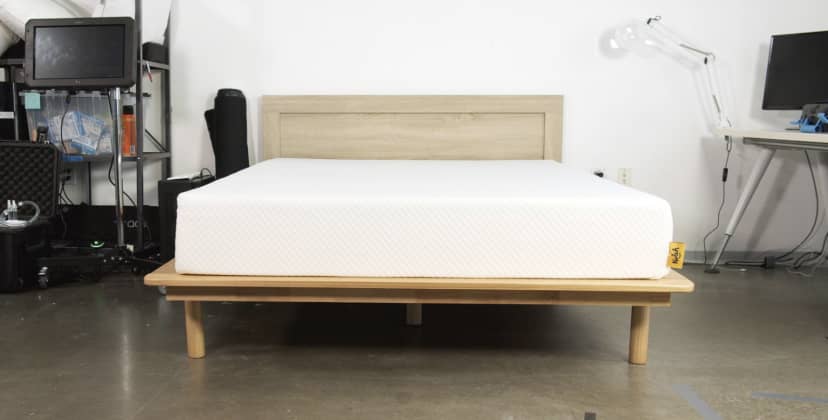

Credit: Sleep Foundation Test Lab
Price
$942
Mattress Type
Foam
Firmness Options
Medium (5)
Trial Period
120 nights (30-night requirement)
At a Glance
- Who It’s Best for: Side sleepers up to 230 pounds and back sleepers under 130 pounds.
- Feel: Plush medium (5) design with deep contouring and light pushback from the support core.
- What It’s Made of: Zoned, open-cell adaptive polyfoam and transitional foam over a high-density foam base.
- What We Don’t Like: Most back and stomach sleepers will find the mattress too soft.
Scoring & Reviews
The following ratings show how suitable this mattress is for different sleeping positions and sleeper weights. These scores are determined by how well the mattress supports and relieves pressure for each sleeper type.
Full Details
The Nolah Original is a 10-inch all-foam mattress designed with cushioning foams that conform to relieve pressure points. Side sleepers typically exert a lot of pressure on the shoulders and hips, so the generous cushioning can help avoid painful pressure buildup.
How It Performs
The Nolah Original falls at a medium, or a 5 out of 10 on our firmness scale. This makes it ideal for side sleepers and those who weigh less than 130 pounds. Sleepers in this weight category often experience pressure points from firmer mattresses, as they don’t exert enough pressure on the mattress to feel a firmer bed’s cushioning. The plush foams also absorb motion well, keeping co-sleepers from waking each other at night.
Due to the open-cell foams used in the comfort system, the Original also resists heat buildup well. You may notice some warmth on the surface, but we found this mattress sleeps much cooler than many of its all-foam competitors. Our team also gave the Original stellar ratings for pressure relief.
Construction Breakdown
A top layer of proprietary AirFoam conforms to the body while providing a slightly bouncy feel. A second layer of transitional polyfoam prevents the body from sinking into the support core but still provides moderate cushioning. The core is composed of a thick layer of high-density polyfoam that provides the support needed to keep the spine aligned and prevent the hips from sinking in.
Trial, Shipping, and Warranty
Six standard sizes are available, as well as a split king size for adjustable beds. Nolah offers a 120-night sleep trial and a lifetime warranty, with free shipping in the contiguous U.S.
Best Luxury Mattress
Birch Luxe
9.3 /10
Test Lab Score
25% off sitewide
25% off sitewide
A luxury mattress means high-quality materials and top-end performance, and that’s exactly what you get in the Birch Luxe. This durable and supportive mattress is constructed with eco-conscious materials that relieve pressure and stay cool all night long.
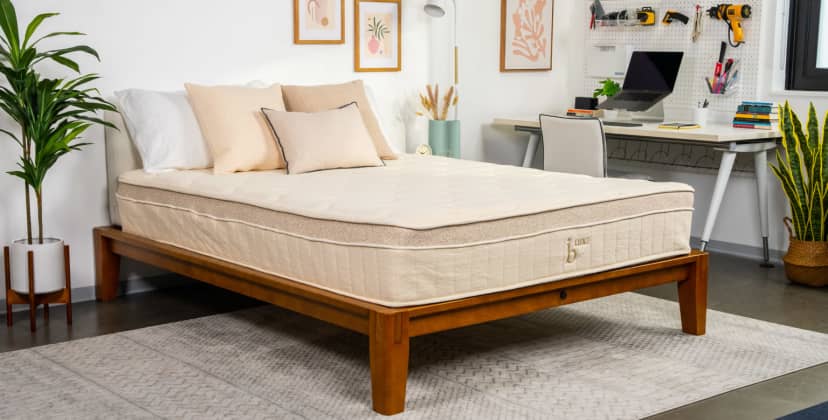
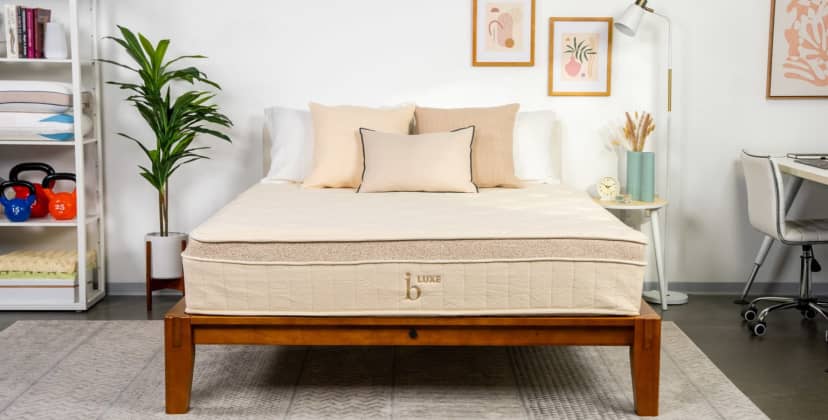
Credit: Sleep Foundation Test Lab
Price
$2,099
Mattress Type
Latex Hybrid
Firmness Options
Medium Firm (6)
Trial Period
120 nights (30-night requirement)
At a Glance
- Who It’s Best for: Side and back sleepers who enjoy a responsive sleep surface.
- Feel: Medium firm (6) feel with gentle cushioning and a strong bounce in response to movement.
- What It’s Made of: Organic wool batting and organic latex comfort layers, followed by a pocketed coil support core with perimeter reinforcement.
- What We Don’t Like: Pricing is on the expensive side – this might be a dealbreaker for budget-minded shoppers.
Scoring & Reviews
The following ratings show how suitable this mattress is for different sleeping positions and sleeper weights. These scores are determined by how well the mattress supports and relieves pressure for each sleeper type.
We performed a meta-analysis on 163 validated customer reviews of the Birch Luxe. This is what people who bought the mattress had to say:- Organic and Eco-Friendly: The mattress is appreciated for being made from natural materials, which is a significant plus for environmentally conscious consumers and those sensitive to chemicals.
- Heat Regulation: Several users have noted that the mattress does not retain heat, making for a cooler sleeping experience compared to other brands.
- Motion Isolation: Couples have reported that the mattress does a good job of isolating motion, meaning that partners are not disturbed by each other’s movements during the night.
- Heavy and Difficult to Set Up: Some negative feedback includes the mattress being heavy and difficult to set up, which could be a challenge for some buyers.
- Price: The mattress is more expensive than other options, but many users feel that the quality and comfort justify the cost.
- Customer Service: There are mixed reviews on customer service, with some customers experiencing great service, while others faced challenges, particularly concerning delivery and handling issues.
Full Details
Eco-conscious shoppers willing to spend a bit more on a mattress with organic materials will enjoy the Birch Luxe. The mattress boasts Global Organic Textile Standard (GOTS) and Rainforest Alliance certifications, ensuring that the materials are sustainably sourced and ethically produced.
How It Performed
Thanks to the medium firm (6) feel, we found the mattress best suited for side sleepers, particularly those who weigh at least 130 pounds. The cushioning from the wool layers and the latex helped relieve pressure in the hips and shoulders without excessive sinkage. Our back and stomach sleepers between 130 and 230 pounds also enjoyed the responsive feel.
Temperature regulation was one of the Luxe’s standout features during our tests. We attribute this to the steady airflow through the coils and the breathable wool and latex comfort layers. Thanks to the bouncy feel, we also recommend the mattress for couples who prioritize responsiveness for sex. We could move across the mattress easily, and the reinforced perimeter prevented us from slipping off the edges.
Construction Breakdown
A quilted Euro-top cover made from GOTS-certified organic cotton gives the Luxe’s surface a plush feel. Underneath is a breathable organic wool-rayon blend layer that acts as a natural fire barrier. Next is an organic wool layer, followed by two layers of organic wool. These layers encourage steady airflow through the comfort system while adding a bit of cushioning. Rainforest Alliance-certified natural latex rounds out the comfort system, offering gentle cradling to relieve pressure points without sinking too deeply.
The support core features pocketed coils in a zoned configuration. Thicker coils are placed in the center of the mattress to provide targeted support to the midsection. Meanwhile, thinner coils cradle the legs and upper body. The thicker coils also reinforce the perimeter of the bed, helping it bear your weight when you sit or sleep near the edges. Underneath is another wool-rayon layer for stability.
Trial, Shipping, and Warranty
Birch ships free to customers in all 50 states. Mattress purchases come with 120-night sleep trials, during which you can test the mattress and return it for a full refund anytime after the 30-night break-in period. The Birch Luxe is backed by a lifetime warranty.
Best Mattress for Combination Sleepers
Leesa Sapira Chill Hybrid
9.0 /10
Test Lab Score
25% off sitewide
25% off sitewide
If you’re a hot sleeper who needs a new full-size mattress, the Leesa Sapira Chill is just what you’re looking for. Built with a focus on temperature regulation, this hybrid also delivers excellent support and is available in three firmness options.
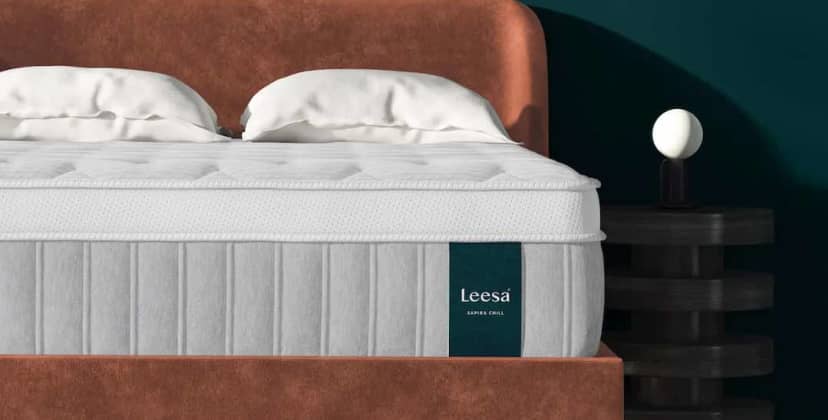
Price
$1,698
Mattress Type
Hybrid
Firmness Options
Medium (5), Medium Firm (6), Firm (7)
Trial Period
120 nights (30-night requirement)
At a Glance
- Who It’s Best for: Most side and back sleepers regardless of weight and stomach sleepers up to 230 pounds.
- Feel: Available in medium (5), medium firm (6), and firm (7) designs, all of which offer a balance of cushioning, support, and bounce.
- What It’s Made of: Comfort layers of gel-infused memory foam and polyfoam over dense transitional foam and zoned pocketed coils with a reinforced periemeter.
- What We Don’t Like: Limited options for stomach sleepers over 230 pounds.
Scoring & Reviews
The following ratings show how suitable this mattress is for different sleeping positions and sleeper weights. These scores are determined by how well the mattress supports and relieves pressure for each sleeper type.
We performed a meta-analysis on 25 validated customer reviews of the Leesa Sapira Chill Hybrid. This is what people who bought the mattress had to say:- Suitability for Different Sleepers: Several reviews highlight that the mattress is suitable for side sleepers, stomach sleepers, and even for those who experience hip and shoulder pain.
- Temperature Regulation: Some reviews mention the mattress being cool and comfortable, while others complain about it sleeping hot, despite being the “Chill” version.
- Quality and Durability Concerns: A few reviewers express concerns about the mattress’s durability or mention receiving a damaged product.
- Overall Satisfaction: While many reviews are overwhelmingly positive, scoring 5 out of 5, there are a few lower scores where users mention issues like the mattress being too soft, too bouncy, or not meeting expectations in terms of firmness and comfort.
- Specific Needs: Some reviews from users with back pain or who have had long-term use of other mattresses indicate that this model significantly improved their sleep quality and comfort.
Full Details
Beds with thick foam layers have a tendency to trap heat, but the Leesa Sapira Chill Hybrid mitigates this issue with thermoregulating features that help keep it cooler than other foam hybrids we’ve tested. The mattress is available in three firmness options to accommodate different types of sleepers.
How It Performed
The mattress is 14 inches thick, which is considered a high profile, and you can opt for a medium (5), medium firm (6), or firm (7) model. All firmness options begin with a soft knit cover infused with cooling fibers. The cover is quilted with gel-infused polyfoam to create a gently plush surface, followed by polyfoam and memory foam layers to enhance contouring. Beneath is a polyfoam with higher density to buffer you from the coil support core.
The coils are zoned to reinforce support to the lower back, which helps promote spinal alignment. The edges are also bolstered to minimize sagging along the perimeter, benefiting sleepers who enjoy using the full surface of the bed.
Construction Breakdown
The mattress is 14 inches thick, which is considered a high profile, and you can opt for a medium (5), medium firm (6), or firm (7) model. All firmness options begin with a soft knit cover infused with cooling fibers. The cover is quilted with gel-infused polyfoam to create a gently plush surface, followed by polyfoam and memory foam layers to enhance contouring. Beneath is a polyfoam with higher density to buffer you from the coil support core.
The coils are zoned to reinforce support to the lower back, which helps promote spinal alignment. The edges are also bolstered to minimize sagging along the perimeter, benefiting sleepers who enjoy using the full surface of the bed.
Trial, Shipping, and Warranty
Leesa offers free shipping throughout all 50 states. You’ll receive a 120-night sleep trial with your purchase, with a lifetime warranty to further back the mattress.
Best Mattress for Kids
Helix Kids
8.3 /10
Test Lab Score
25% off sitewide
25% off sitewide
The Helix Kids Mattress provides a full-size sleeping surface while offering excellent support and dual-sized design. Different firmness levels on each side mean that your mattress can adapt to your child’s needs and preferences as they grow.
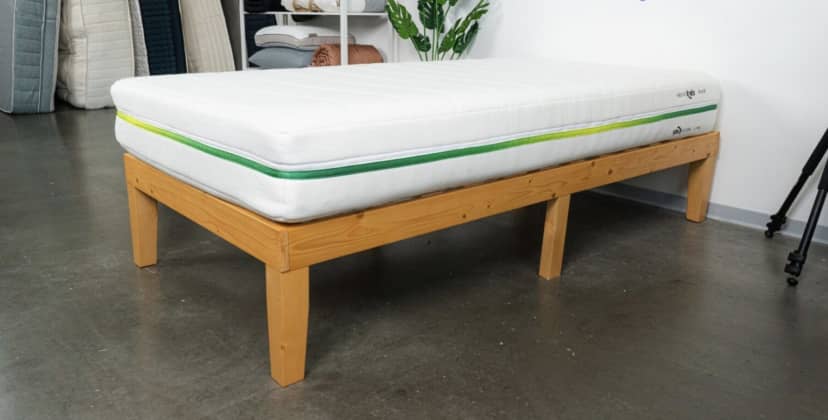
Credit: Sleep Foundation Test Lab
Price
$749
Mattress Type
Hybrid
Firmness Options
Medium Soft (4), Medium Firm (6)
Trial Period
120 nights (30-night requirement)
At a Glance
- Who It’s Best for: Kids between the ages of 3 and 12.
- Feel: Supportive medium firm (6) on the side meant for kids 3 to 7, plush and medium soft (4) on the side for kids 8 to 12.
- What It’s Made of: Gel-infused memory foam with a water-repellent barrier and antimicrobial coating on each side, with a shared support core of pocketed coils located between the comfort systems.
- What We Don’t Like: Expensive pricing compared to other kid-friendly mattresses.
Scoring & Reviews
The following ratings show how suitable this mattress is for different sleeping positions and sleeper weights. These scores are determined by how well the mattress supports and relieves pressure for each sleeper type.
We performed a meta-analysis on 514 validated customer reviews of the Helix Kids. This is what people who bought the mattress had to say:- Versatility: The mattress is flippable with different firmness levels, making it suitable for children as they grow. This feature is highly valued by parents looking to make a long-term investment in a mattress.
- Material Quality: Users generally report that the mattress is made from high-quality materials, contributing to its durability and comfort.
- Smell and Off-gassing: Some users report a noticeable smell upon unpackaging, which can take a few days to dissipate. This is a common issue with new mattresses but can be a concern for sensitive individuals.
- Size Issues: There are occasional complaints about the mattress not fitting perfectly in standard frames, sometimes being slightly shorter or narrower than expected.
- Customer Service: Helix generally receives positive reviews for customer service, with prompt and helpful responses. However, there are isolated reports of delivery issues or difficulty arranging returns.
Full Details
The Helix Kids Mattress is a flippable hybrid bed with different firmness levels on each side, with each firmness catering to children in different age groups. This dual-sided design allows the mattress to grow with your child from toddler to teen years.
How It Performed
Both sides, especially the softer side, excel in pressure relief, making the bed well suited for kids who sleep on their sides and experience sharp pressure points in the shoulders and hips. The soft side’s plush surface also absorbs movement effectively, so your child won’t feel much movement if sharing the bed with a parent or pet. Reinforced edges can also help prevent children from rolling off the bed in the middle of the night.
Construction Breakdown
The mattress features a soft side with a medium soft (4) feel, aimed at older children, and a firm side that rates medium firm (6), designed with younger children in mind. The firmer side begins with a layer of dense polyfoam that gently contours to the body while providing ample support for growing bodies. The softer side begins with a memory foam layer that offers deeper contouring than the opposite side, creating a comfortably plush surface.
Both sides share a support core of pocketed coils that provide ample pushback but also gently cradle the body. The coils are reinforced around the perimeter so the bed won’t sag when your child sits or sleeps close to the edges. A breathable Tencel cover encases the entire mattress with a plant-based water-repellent treatment designed to protect the mattress from spills and nighttime accidents.
Trial, Shipping, and Warranty
Helix mattresses are backed by a 120-night sleep trial and lifetime warranty. Helix ships free throughout the contiguous U.S.
Best Mattress for Pressure Relief
My Green Mattress Kiwi Organic Mattress
8.2 /10
Test Lab Score
Get your discount with code: Foundation
Get your discount with code: Foundation
If you are searching for a full mattress with exceptional pressure relief, the My Green Mattress Kiwi Organic is right on target. With latex hybrid construction and a medium (5) firmness level, it fully cushions high-impact areas without letting you sink into the bed. As an added benefit, it is made with organic and sustainable materials.
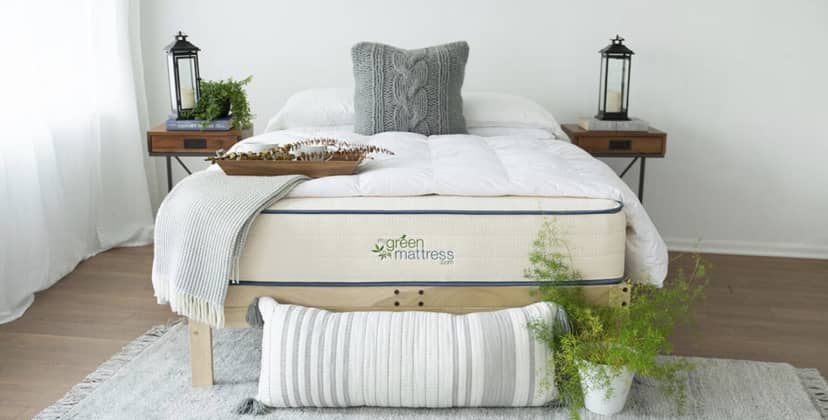
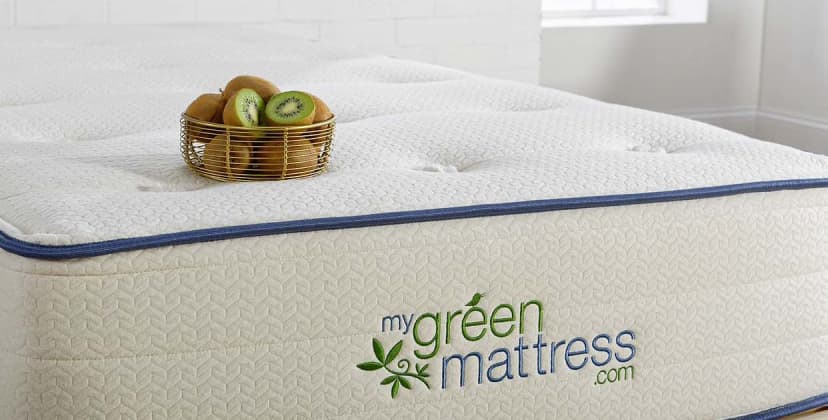
Price
$999
Mattress Type
Latex Hybrid
Firmness Options
Medium (5)
Trial Period
365 nights (30-night requirement)
At a Glance
- Who It’s Best for: Side sleepers up to 230 pounds and back sleepers under 130 pounds.
- Feel: Medium (5) feel with noticeable contouring, but also responsive to movement and supportive beneath the torso and hips.
- What It’s Made of: A 2-inch comfort layer of organic latex over seven-zone pocketed coils with perimeter reinforcement.
- What We Don’t Like: People who weigh more than 230 pounds will probably find the mattress too soft.
Scoring & Reviews
The following ratings show how suitable this mattress is for different sleeping positions and sleeper weights. These scores are determined by how well the mattress supports and relieves pressure for each sleeper type.
We performed a meta-analysis on 542 validated customer reviews of the My Green Mattress Kiwi Organic Mattress. This is what people who bought the mattress had to say:- Organic Materials: Many reviewers appreciate that the mattress is made from organic and non-toxic materials, offering a healthier sleeping environment.
- Durability and Quality: Positive feedback highlights the mattress’s well-constructed design and durability, with several users being repeat customers due to the quality.
- Size Issues: Some customers have noted discrepancies in the mattress sizes, stating that the mattress they received was smaller than advertised, which caused fitting issues with their bed frames.
- Off-Gassing: Reviewers often highlight the lack of off-gassing smells, which is a common issue with new mattresses, making this a standout feature for those sensitive to odors.
- Value: The mattress is frequently praised for its affordability compared to other organic mattresses in the market, offering good value for the money.
- Customer Service: Positive experiences with customer service are commonly mentioned, with reviewers appreciating the responsive and helpful support team.
Full Details
The Kiwi Organic Mattress from My Green Mattress is a latex hybrid that offers the best of both worlds when it comes to support and contouring. The responsive feel offers plenty of support for your body while still cradling sensitive pressure points like your shoulders and hips. The zoned design delivers extra contouring where it’s most needed.
How It Performed
The Kiwi Organic Mattress has a medium (5) firmness that’s perfectly suited for side sleepers up to 230 pounds. These sleepers experienced just enough pressure relief for the shoulders and hips without sinking too deep into the bed to cause awkward spinal alignment. Back and stomach sleepers under 130 pounds also found the mattress comfortable. One of the bed’s biggest strengths was temperature regulation, due in large part to the natural cooling properties of latex, wool, and cotton. The bed’s responsive surface received high marks for ease of movement, as well.
Construction Breakdown
The mattress begins with a layer of wool batting that lightly cushions your body and acts as a flame retardant. This is followed by a layer of Dunlop latex, which has a slightly buoyant feel that gently conforms to your body. Beneath is a pocketed coil support core that generates sturdy support for the entire mattress. This layer is zoned to bolster the lower back and promote healthy spinal alignment. The perimeter of the bed is lined with reinforced coils to prevent excessive sagging when you sit or sleep near the edges. A breathable organic cotton cover encases the mattress.
While many beds come with organic claims, the Kiwi Organic Mattress has certifications to back up these claims. The latex carries certification from the Global Organic Latex Standard (GOLS) to ensure the material was organically sourced, and the wool and cotton are both organically certified by the Global Organic Textile Standard (GOTS).
Trial, Shipping, and Warranty
My Green Mattress offers a generous 365-night sleep trial to try the mattress at home. It’s also backed by a 20-year warranty. Shipping is free to addresses in the contiguous U.S.
The Best Deals of the Week
-
Save $199
—
Brooklyn Bedding CopperFlex Memory Foam
$466 (List Price $665) -
Save $600
—
Helix Midnight Luxe
$1,799 (List Price $2,399) -
Save $2,436
—
Nectar Adjustable Bundle
$1,398 (List Price $3,834) -
Save $771
—
WinkBed
$1,799 (List Price $2,570) -
Save $1,020
—
DreamCloud Classic Hybrid
$699 (List Price $1,719)
Best Overall
Helix Midnight Luxe
9.7 /10
Test Lab Score
25% off sitewide
Shop at HelixA well-built hybrid that offers excellent all-around performance for a full size mattress.
See More Details
Best Value
Brooklyn Bedding CopperFlex Memory Foam
8.6 /10
Test Lab Score
30% off sitewide
Shop at Brooklyn BeddingA wallet-friendly all-foam mattress that offers plush cushioning on the surface and robust support.
See More Details

Credit: Sleep Foundation Test Lab
Most Comfortable
WinkBed
9.4 /10
Test Lab Score
30% off all WinkBeds mattresses
Shop at WinkBedsSpinal support and back pain relief from a sturdy and supportive full mattress.
See More Details
Best for Back Pain
Bear Elite Hybrid
8.5 /10
Test Lab Score
40% sitewide with code: SF40
Shop at BearA great option for a full-size hybrid mattress that can accommodate people who switch between sleeping positions.
See More Details
Best for Side Sleepers
Nolah Original 10
8.0 /10
Test Lab Score
35% off sitewide + extra $100 off with code: SF100
Shop at NolahA full-size mattress that delivers first-rate cushioning and pressure relief.
See More Details

Credit: Sleep Foundation Test Lab
Best Luxury
Birch Luxe
9.3 /10
Test Lab Score
25% off sitewide
Shop at BirchA latex hybrid with standout performance and eco-friendly design that’s luxuriously comfortable in a full size.
See More Details
Best for Combination Sleepers
Leesa Sapira Chill Hybrid
9.0 /10
Test Lab Score
25% off sitewide
Shop at LeesaA full-size hybrid that keeps the entire surface of your mattress cool and comfortable.
See More Details
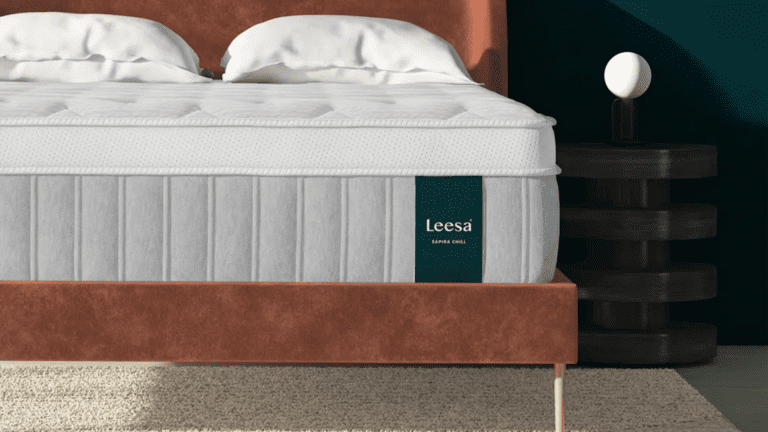
Best for Kids
Helix Kids
8.3 /10
Test Lab Score
25% off sitewide
Shop at HelixA reversible full-size mattress that gives your child two firmness levels to choose from.
See More Details
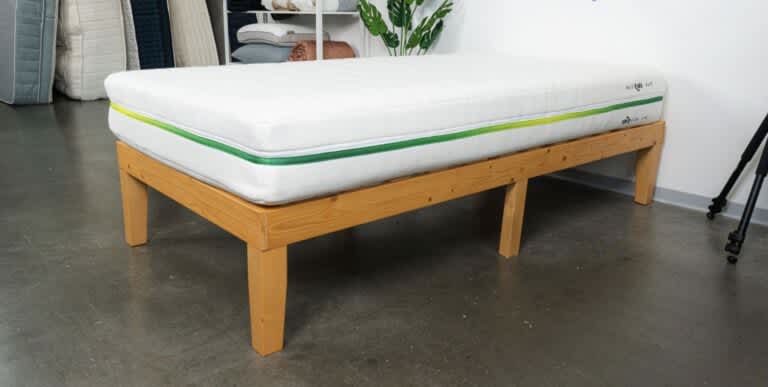
Best for Pressure Relief
My Green Mattress Kiwi Organic Mattress
8.2 /10
Test Lab Score
Get your discount with code: Foundation
Shop at My Green MattressA full mattress featuring hybrid construction, sustainable materials, and standout pressure relief.
See More Details
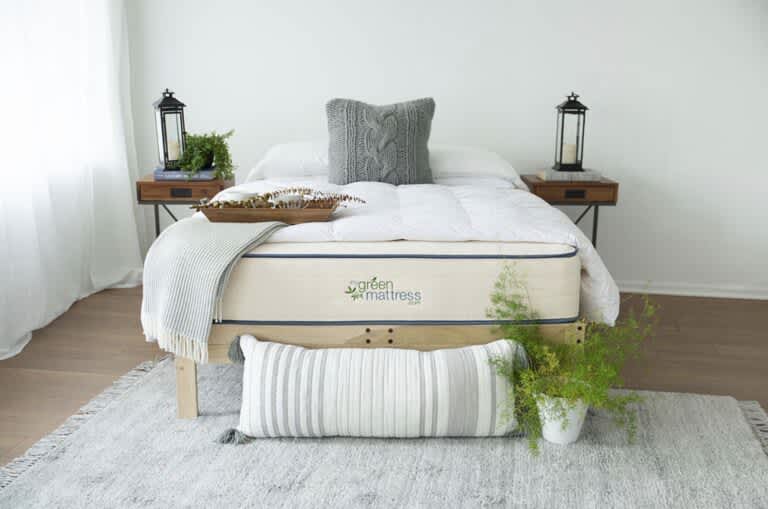
Who Should (and Shouldn’t) Sleep on a Full Size Mattress?
Full size mattresses offer plenty of space without dominating a small room. Based on our experience in the sleep product industry, we’ve found that certain groups fit best with a full size mattress.
| Single Adults | Not everyone wants a large mattress, and a full offers adequate space for one person without overwhelming a room. |
| Children | Full mattresses are a logical choice after a toddler bed, offering ample space for growth through childhood and adolescence. |
| Teenagers | Full size mattresses are great for growth spurts and provide a nice balance of space and efficiency. |
| College Students | This size is a practical choice for dorms and apartments, maximizing sleeping space in smaller rooms. |
| Guest Rooms | Full size mattresses are an excellent choice for guest rooms, fitting comfortably in most rooms while allowing additional space for dressers, desks, and other furniture. |
Although full or double mattresses are versatile, there are many situations where a different size would be more suitable.
- Couples: Co-sleepers may find a full mattress too restrictive for two people.
- Taller individuals: At 75 inches long, which is 6 feet and 3 inches, a full size mattress may be too short for people over six feet tall.
- Those with large bedrooms: Full size mattresses can seem disproportionately small in a spacious room. People with spacious rooms or open floor plans should consider a queen or larger.
What Is the Difference Between a Full and Queen?
Full mattresses are more space-efficient and budget-friendly than queens, making them ideal for solo sleepers and smaller rooms. The next largest standard mattress size, the queen, offers an additional 6 inches in width and 5 inches in length, making it a better choice for couples and taller sleepers.
| Full/Double Mattress | Queen Mattress |
|---|---|
| 54″ x 75″ | 60″ x 80″ |
How to Pick the Best Full Mattress for You
When shopping for a full size mattress, consider how your body weight, sleeping position, budget, and preferences translate into a mattress type, level of firmness, and specific mattress features.
Your Sleeping Position and Weight
Back and stomach sleepers often benefit from firmer support, while side sleepers usually need a softer mattress for pressure relief. On the same note, people over 230 pounds should choose a more supportive mattress, whereas sleepers under 130 pounds can opt for a softer feel.
Mattress Type and Firmness
Be it full size foam, latex, innerspring, or hybrid, every type of mattress has its pros and cons. For example, all-foam mattresses provide excellent contouring and pressure relief, while latex models offer a balance of support and bounce. Innerspring mattresses are known for their responsiveness and breathability, and hybrids combine these elements for a versatile choice.
Regardless of the type you choose, a mattress’ firmness level should align with your sleeping position and weight: softer for side sleepers and people under 130 pounds, medium for most sleepers, and firmer for back sleepers and those with a heavier build.
Contouring and Pressure Relief
A mattress that contours well adapts to your body shape, distributing weight evenly and keeping the spine in alignment for healthy sleep posture. Pressure relief helps reduce stress on muscles and joints and is particularly important for side sleepers and those prone to pain.
Pricing, Sleep Trial, and Warranty
Full/double mattresses range in price from budget to luxury, depending on brand, materials, and construction. We suggest buying a mattress within your budget that doesn’t compromise on quality.
Sleep trials and warranties offer peace of mind, allowing you to test the mattress in your home and ensuring protection against manufacturer defects. These protections are especially helpful if it’s your first time buying a mattress or if you’re uncertain about whether a full size is the right choice for your space.
Watch Video: How to Buy a Mattress
Watch our video below to learn more about what to consider when buying a new mattress.
How We Test: Your Comfort Is Our Science
Our industry-leading product testing team cares deeply about improving your sleep. Having a holistic understanding of a mattress’s role as part of a sleep system is paramount to our testing process. Since a bed’s comfort and feel depend largely on body weight and sleeping position, our testing team represents a wide range of body types, sleep positions, and comfort preferences.
In our Seattle-based Test Lab, we use an objective, hands-on process to evaluate mattresses across performance categories. The following are the key guidelines that inform our performance ratings. Our ultimate goal is to ensure you have all the information you need to make the best purchase decision for you.
Construction analysis: We begin testing each mattress by analyzing its design and making note firmness, height, individual layer composition, and sticker price. This allows us to evaluate qualities like support, durability, and value.
Product testing: Firsthand testing is crucial to our evaluation and ratings system. We use a wide range of tools and technology to test mattresses in six performance categories: motion isolation, pressure relief, temperature control, ease of movement, edge support, and odor potential.
Field testing: In addition to lab-based tests, we base our ratings on feedback from field testers who use the mattresses in their own homes. They spend several weeks collecting data — this gives us insights into how the mattress performs night after night for an extended period.
User testing: We curate feedback verified owners have provided in surveys, sleep stories, and product reviews. This helps us evaluate our initial findings and, if needed, tweak our ratings to reflect real-world experiences.
How We Determine Our Overall Scores


To determine a mattress’s overall score, we assign weighted percentages to performance categories based on how important they are to the individual sleep experience. For instance, areas like pressure relief and temperature control tend to matter more to people than something like off-gassing, and because more people sleep on their side and back than on their stomach, we weigh those positions more heavily.
Performance Categories
Motion Isolation
This criteria alludes to the amount of motion a mattress absorbs when a sleeper moves on the surface. We use two testers lying side by side to evaluate motion isolation, who each feel for transfer while the other person moves on the mattress.
Temperature Control
To determine how well a mattress regulates temperature, we perform temperature tests and look closely at its materials and construction. Many mattresses are designed with cooling components meant to reduce heat retention.
Pressure Relief
A bed with strong pressure relief excels at preventing pressure from building up in areas like the shoulders and hips. Beds with even contouring and weight distribution are top performers when it comes to pressure relief.
Off-Gassing
A mattress in a box may release unpleasant chemical odors for a short period after you’ve unboxed it. The initial smell may be strong but typically fades within 2 or 3 days.
Ease of Movement
This criteria reflects how easily a sleeper can move across a bed’s surface. Responsive surfaces made of latex typically perform better than foam surfaces, which can inhibit movement.
Edge Support
We perform sit tests along a bed’s perimeter to measure how well the edges push back against weight. Mattresses with strong edge support have minimal sagging when sleepers sit on or lie close to the perimeter.
Dive Deeper – Mattress Guides by Size
If you want to expand your search for a new mattress beyond full and double beds, you can take a look at our detailed recommendations broken down by mattress size.
Frequently Asked Questions
What is the best full size mattress?
There’s no single best full size mattress for every sleeper. Instead, choose a mattress that meets your unique needs and preferences. Key factors to consider include mattress type, firmness, budget, and what feels good to you. Generally, a mattress that offers a balance of support and comfort, aligns with your sleeping style, and falls within your budget would be considered the best choice.
What are the dimensions of a full size mattress?
A full size mattress measures 54 inches in width and 75 inches in length. This mid-size choice is ideal for single adults or teenagers, providing ample space to sleep comfortably while being compact enough to fit in smaller bedrooms and guest rooms.
How much does a full mattress cost?
The cost of a full mattress can vary, ranging from budget-friendly options around $200 to luxury models exceeding $1,000. Factors influencing the price include the mattress type, quality, brand reputation, and additional features like cooling technology or organic materials. Fortunately, it’s possible to find a quality full mattress to suit most budgets.
How much does a full mattress weigh?
The weight of a full mattress depends on its construction and materials. On average, a full size foam mattress weighs between 50 to 75 pounds, while innerspring, latex, and hybrid models can weigh up to 100 pounds or more. The weight of a mattress is an important consideration for transport and setup.
Can you use a full mattress for a bunk bed?
A full mattress can be used for a bunk bed, provided the bunk bed is designed to accommodate a full size. This is often seen in twin-over-full bunk beds, where the lower bunk is full-sized and the upper bunk is twin-sized. Always check the bunk bed’s specifications before buying a new mattress.

Still have questions? Ask our community!
Join our Sleep Care Community — a trusted hub of product specialists, sleep health professionals, and people just like you. Whether you’re searching for the perfect mattress or need expert sleep advice, we’ve got you covered. Get personalized guidance from the experts who know sleep best.

